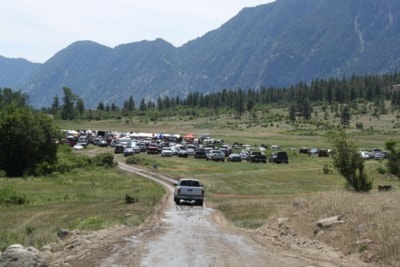This historical account of the Chopaka area, written by Ann Briley and published in the Okanagan Historical Society’s annual report of 1964, relates to the early beginnings of border security in the South Similkameen.
Chopaka, the pronunciation of which rhymes with tobacco, is a native name which signifies “lofty’, or ‘grand” and refers to the mountain cone of the same name which stands out like a beacon over a tremendously wide area. Chopaka is nowadays a dead end street. Border restrictions have clamped down in such a way that even residents of the valley have a difficult time in crossing over the line. The U.S. Immigration Service has put up a gate - to be sure, it is not on the line but a mile south - which is kept padlocked at all times. A local rancher, Claude Cutchie, plus the Great Northern section foreman at Oroville, are the only two persons aside from the official patrolmen, who have a key to this iron gate. Passenger service on the Great Northern was discontinued some years ago, thus further isolating the Canadian side of the valley. The effort is being made to discourage international crossing at this point, the Justice Department boys having set up a port of entry three miles out of the valley on a high bench of land which is set athwart the main international road out of Nighthawk.
To summarize, any road traffic stemming up through Washington State to the obscure valley, is forced back a mile south of the border, while any Canadian traveller leaving the fairly well travelled road through regular Customs channels, must take a branch road leading across the Chopaka Indian Reservation and ultimately, if braving the hazards thereof, will come to the same obstacle - the gate.
The circumstance is in strong contrast to the free, unencumbered life enjoyed in the valley up to approximately a decade ago. Precedent had been set at the earliest settlement of the long valley when ranchers were encouraged to enter British Coloumbia. The early ranchers along the border, Indian and white, were committed to a broad disregard for the imaginary line set along the 49th parallel. Cattle, horses, visitors to dances and celebrations anywhere within practical distance, drifted back and forth unobstructed. Needless to say this epoch passed; officialdom raised it picayune head; signs were erected and the first gates attempted. Though the local citizenry railed at the new bureaucracy, destiny of nations prevailed and the old free life was gone.
First settler in the valley stateside was Pete Alonzo Anderson, a colourful burly fellow with many sons, who came in 1882 after a varied career in the gold fields of B.C. and farming in the Nicola Valley. Grass and water were free and so was homestead land. He was quickly followed by Jack Cutchie and Joseph Lenton and down around Palmer Lake, two Englishmen, the Champney brothers, Weldon and Vic.
By the 1890’s the mining excitement was in full swing. Several local mills employed a fairly large population of workers, and there was placering on the side, and scores of of other hopefuls who expected always on the morrow to “uncover another Comstock”. Sawmills - five of them in all - chewed up the denses woodland on the valley floor. For such activities, produce, firewood, meat were necessary and thus many small farms came into being, until the valley was well settled and had a rather nice social life within it. With gold and trees used up, the place dwindled rapidly until it is now - a dead end street.
